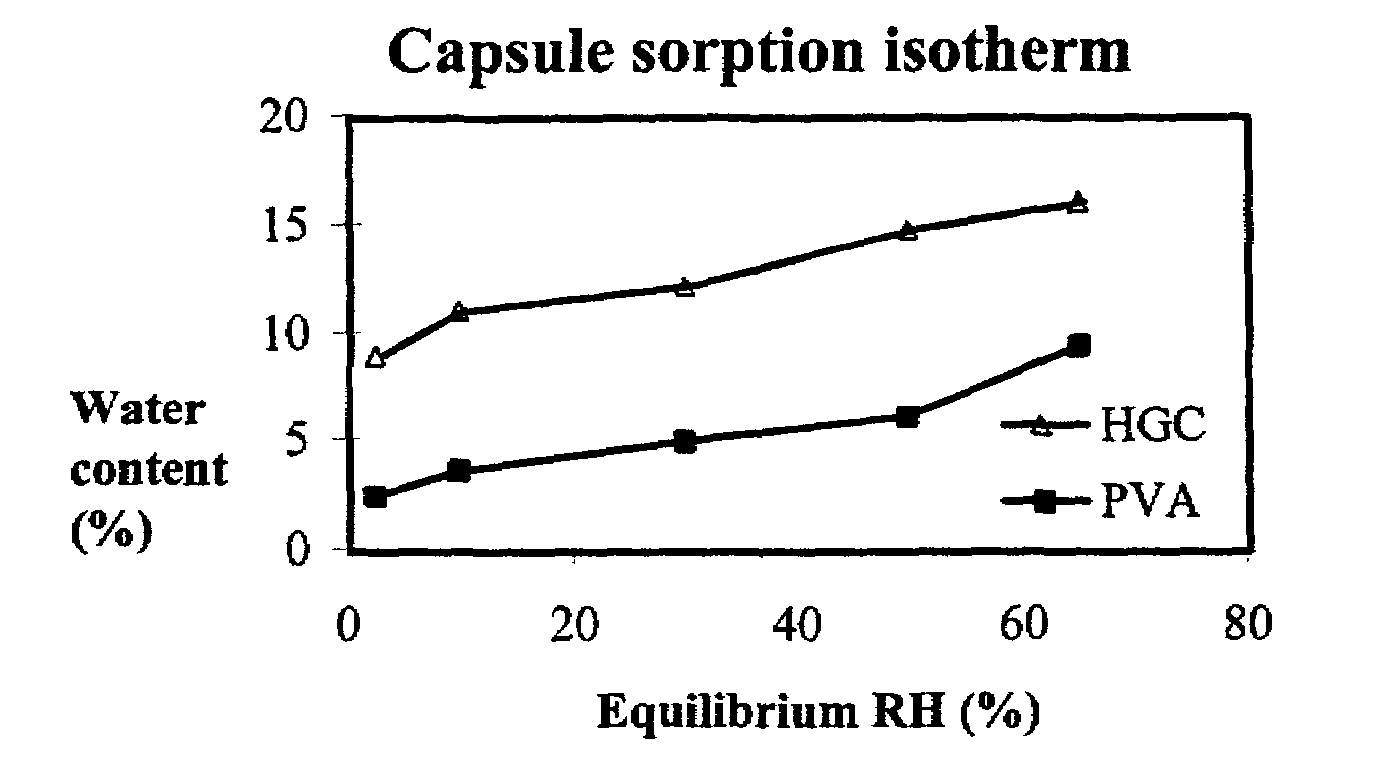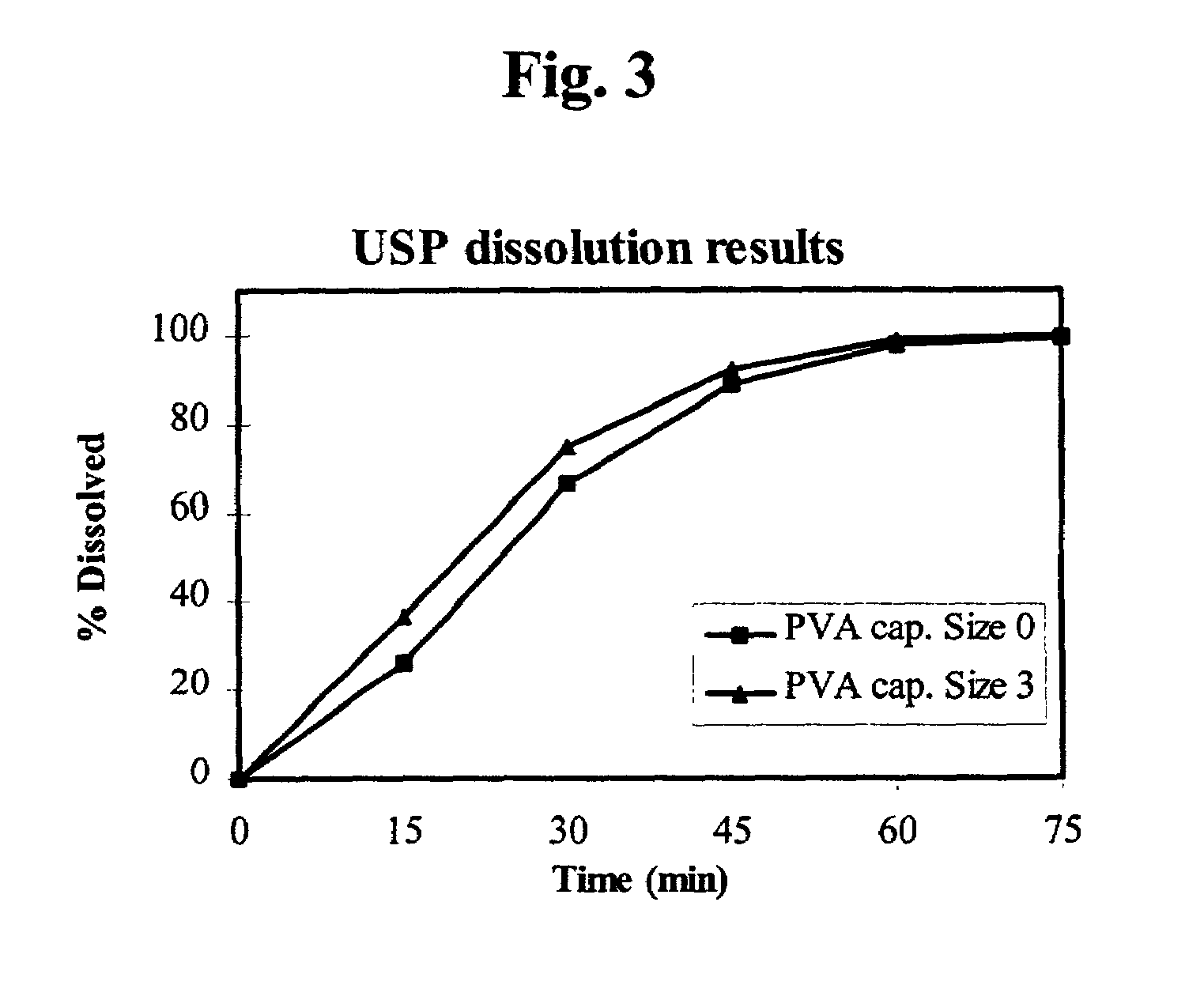Polyvinyl alcohol compositions
a polyvinyl alcohol and composition technology, applied in the direction of rigid containers, synthetic resin layered products, packaging, etc., can solve the problems of adversely affecting the properties of fills, high water vapour transport rate, and moisture exchange between capsules and fills, so as to improve the setting ability of pva solutions.
- Summary
- Abstract
- Description
- Claims
- Application Information
AI Technical Summary
Benefits of technology
Problems solved by technology
Method used
Image
Examples
example 1
Hard PVA Capsule Production
[0041]To 3.50 kg of deionised water is added 5 g of potassium acetate (0.10% by weight in the solution), followed by addition of 10 g kappa-carrageenan (0.20% by weight) and 2 g of Montane 80 (as anti-foaming agent, 0.04%) under stirring at about 70° C. When kappa-carrageenan is dissolved, 1.35 kg (27% by weight) of PVA (which has a viscosity of 5 cps for a 4% aqueous solution at 20° C.) is added at 60° C. under slow stirring until the PVA is completely dissolved and the solution is defoamed.
[0042]The PVA solution thus prepared is then poured into a dipping dish of a pilot machine of conventional hard gelatine capsule production equipment. While keeping the temperature of dipping PVA solution at about 60° C., natural transparent hard PVA capsules of size 0 and size 3 were produced according to the conventional process with the same dimensional specifications to the conventional hard gelatine capsules. Expectable from the extremely low water vapour permeabi...
example 2
Water Vapor Sorption of Hard PVA Capsules
[0043]The sorption isotherm of PVA capsules according to example 1 has been investigated and compared with the isotherm of hard gelatin capsules. The experiments demonstrate that PVA capsules have much lower hygroscopicity than HGC.
[0044]The results are shown in FIG. 1.
example 3
Moisture Take-up of Hard Capsule Fills
[0045]The moisture take-up of fills encapsulated in PVA capsules or HGC has been investigated. The capsules were equilibrated at 22° C. and 50% RH, then filled with dried polyvidone or dried maize starch. After closing, the capsules were stored at 22° C. and 50% RH. The moisture take-up by the capsule fills have been determined by the increase of the weight of the filled capsule. The experiments demonstrate that PVA capsules have extremely low water vapour permeability.
[0046]The kinetics of moisture take-up are shown in FIG. 2.
[0047]Table 1 shows the proportion of the permeabilities of PVA capsules and hard gelatin capsules:
[0048]
TABLE 1FillPolyvidoneMaize starchPermeability (PVA cap.)0.0170.027Permeability (HGC)
PUM
| Property | Measurement | Unit |
|---|---|---|
| temperature | aaaaa | aaaaa |
| RH | aaaaa | aaaaa |
| weight | aaaaa | aaaaa |
Abstract
Description
Claims
Application Information
 Login to View More
Login to View More - R&D
- Intellectual Property
- Life Sciences
- Materials
- Tech Scout
- Unparalleled Data Quality
- Higher Quality Content
- 60% Fewer Hallucinations
Browse by: Latest US Patents, China's latest patents, Technical Efficacy Thesaurus, Application Domain, Technology Topic, Popular Technical Reports.
© 2025 PatSnap. All rights reserved.Legal|Privacy policy|Modern Slavery Act Transparency Statement|Sitemap|About US| Contact US: help@patsnap.com



